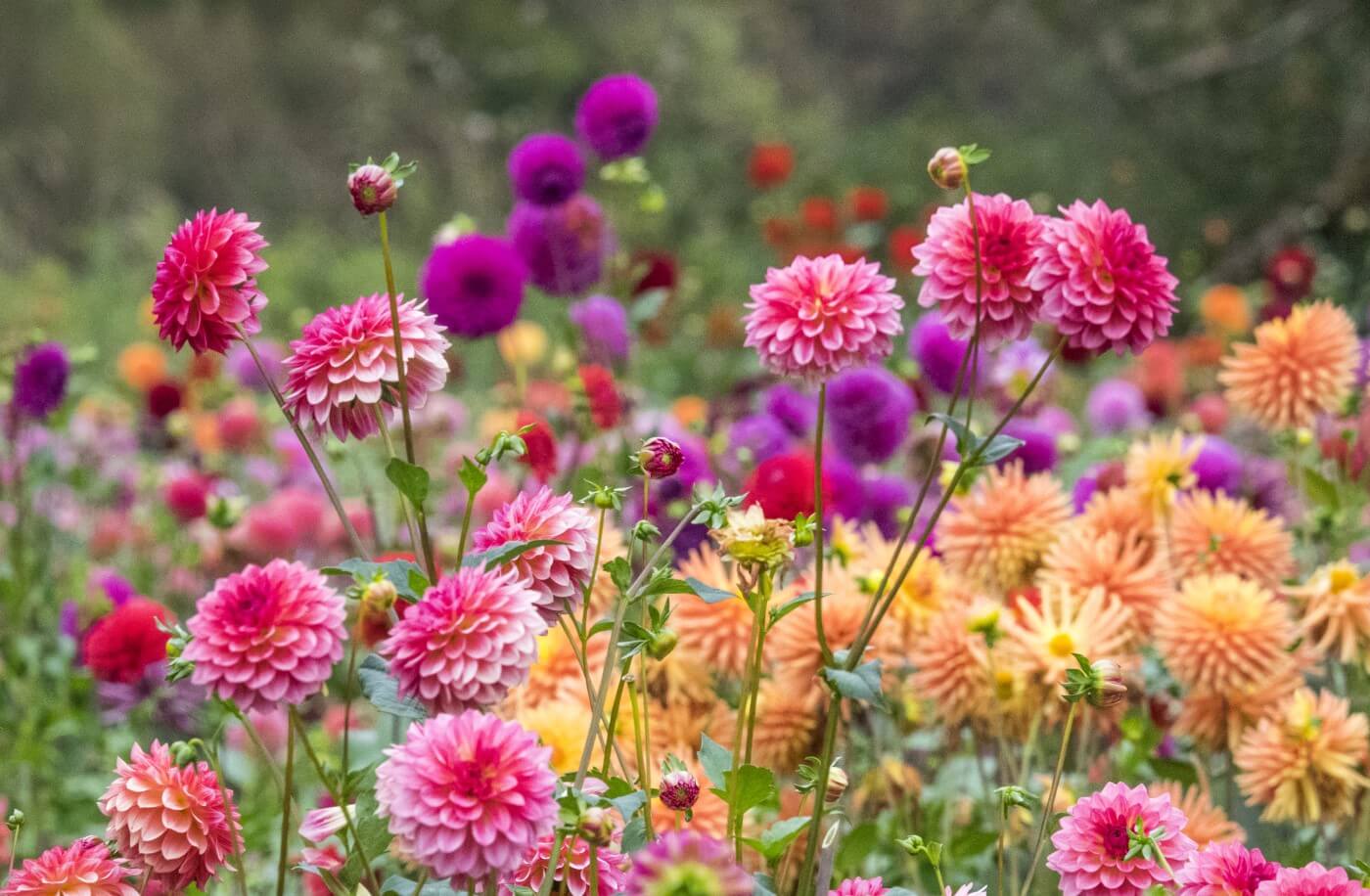
Dahlias are vibrant and captivating flowers that have captivated plant enthusiasts for centuries. With their wide range of colors and intricate petal formations, dahlias are a favorite among gardeners and floral enthusiasts alike. Beyond their beauty, dahlias are also fascinating plants with a rich history and interesting characteristics. In this article, we will explore 15 intriguing facts about dahlias that will pique your curiosity and deepen your appreciation for these stunning blooms. From their origins in Mexico to their popularity around the world, we will delve into the unique qualities that make dahlias a truly remarkable plant. So, let’s dive in and uncover the fascinating world of dahlias!
Key Takeaways:
- Dahlia flowers originated in Mexico and come in a wide range of colors and sizes, attracting pollinators and symbolizing elegance and dignity. They can even be eaten as a unique culinary delicacy!
- With a long blooming season and the ability to be propagated, dahlias are not only beautiful but also deeply rooted in Mexican culture as the national flower, symbolizing love and commitment.
Dahlia flowers are native to Mexico.
The dahlia flower, known for its vibrant and diverse colors, originates from Mexico. It was first discovered by European explorers in the late 18th century during their expeditions to the New World.
Dahlia flowers come in various shapes and sizes.
One of the fascinating aspects of dahlias is their wide variety of shapes and sizes. From delicate single-petaled flowers to large, fully double flowers resembling pom-poms, there is a dahlia for every preference.
There are over 42,000 registered dahlia cultivars.
Dahlias have been cultivated for centuries, resulting in a staggering number of registered cultivars. With such a vast selection, enthusiasts can find dahlias in almost any color and combination of hues imaginable.
Dahlia flowers are loved by pollinators.
The rich nectar and pollen of dahlia flowers attract a wide range of pollinators, including bees, butterflies, and hummingbirds. This makes them not only beautiful additions to gardens but also important contributors to local ecosystems.
The Dahlia is the official flower of Seattle.
Seattle, known for its lush gardens and green spaces, officially designated the dahlia as its city flower in Every year, the city hosts the Seattle Dahlia Society’s Annual Dahlia Show, showcasing the stunning beauty of these flowers.
Dahlias were named after Swedish botanist Anders Dahl.
The dahlia was named in honor of Anders Dahl, an 18th-century Swedish botanist and student of Carl Linnaeus. Dahl made significant contributions to the field of botany, and his name is forever associated with these exquisite flowers.
Dahlias are symbols of elegance and dignity.
Due to their striking beauty and diverse range, dahlias have become symbols of elegance and dignity. They are often used in floral arrangements and bouquets for special occasions such as weddings and formal events.
Some dahlia flowers can reach sizes of up to 12 inches in diameter.
While the size of dahlias varies, certain varieties can produce flowers that are as large as a dinner plate. These giant blooms are truly a spectacle to behold and can make a stunning focal point in any garden.
Dahlia tubers can be eaten.
In addition to their ornamental value, dahlia tubers are also edible. In some cultures, these nutritious tubers are used as a food source, often boiled or roasted and enjoyed as a unique culinary delicacy.
Dahlia flowers can have a wide range of colors, including bi-color and multi-color patterns.
From vibrant reds and oranges to soft pastels and pure whites, the color range of dahlias is truly remarkable. Some varieties even exhibit bi-color or multi-color patterns, adding to their visual appeal.
Dahlias are members of the Asteraceae family, which includes sunflowers and daisies.
Belonging to the Asteraceae family, dahlias are part of the same botanical family as sunflowers and daisies. This family is known for its composite flower heads made up of numerous individual flowers.
Dahlias can bloom from mid-summer through autumn.
One of the advantages of growing dahlias is their long blooming season. Depending on the variety, dahlias can produce flowers from mid-summer all the way through autumn, providing a bright and colorful display for months.
Dahlias can be propagated through division or stem cuttings.
If you have a dahlia plant you particularly adore, you can propagate it through division or stem cuttings. This allows you to create multiple plants and expand your dahlia collection.
The dahlia is the national flower of Mexico.
Given its Mexican origins, it is no surprise that the dahlia holds the status of being the national flower of Mexico. It is deeply woven into the country’s culture and history, representing beauty and national pride.
Dahlia flowers can symbolize love and commitment.
In the language of flowers, dahlias are often associated with love and commitment. They can be a meaningful gift for anniversaries, weddings, or any occasion where affection and devotion are celebrated.
Conclusion
In conclusion, dahlias are truly fascinating and captivating flowers. With their wide variety of colors, sizes, and shapes, they have captured the hearts of gardeners and flower enthusiasts around the world. From their rich history and cultural significance to their unique characteristics and growing requirements, there is so much to learn and appreciate about dahlias. Whether you are a seasoned gardener or a beginner, adding dahlias to your garden will surely enhance its beauty and provide you with years of colorful blooms. So, the next time you come across a dahlia, take a moment to admire its intricate petals and remember these intriguing facts about this remarkable flower.
FAQs
Q: What is the origin of the dahlia flower?
A: The dahlia flower is native to Mexico and Central America.
Q: How many different varieties of dahlias are there?
A: There are over 42 different species and thousands of hybrid varieties of dahlias.
Q: What colors do dahlias come in?
A: Dahlias come in a wide range of colors, including red, yellow, orange, pink, purple, and white.
Q: How tall do dahlias grow?
A: The height of dahlias can vary depending on the variety, but they can grow anywhere between 1 to 6 feet tall.
Q: Do dahlias require a lot of maintenance?
A: Dahlias require regular watering, fertilization, and deadheading, but they are relatively low-maintenance compared to other flowers.
Q: What is the best time to plant dahlias?
A: Dahlias are typically planted in the spring after the danger of frost has passed.
Q: Can dahlias be grown in pots?
A: Yes, dahlias can be grown in pots, but they will require a larger container to accommodate their root system.
Q: Do dahlias attract pollinators?
A: Yes, dahlias are known to attract bees, butterflies, and other pollinators to the garden.
Q: How long do dahlias bloom?
A: Dahlias can bloom from early summer to the first frost, providing a long-lasting display of vibrant colors.
Q: Can dahlias be used as cut flowers?
A: Absolutely! Dahlias make excellent cut flowers and are often used in floral arrangements due to their beautiful blooms and long vase life.
Was this page helpful?
Our commitment to delivering trustworthy and engaging content is at the heart of what we do. Each fact on our site is contributed by real users like you, bringing a wealth of diverse insights and information. To ensure the highest standards of accuracy and reliability, our dedicated editors meticulously review each submission. This process guarantees that the facts we share are not only fascinating but also credible. Trust in our commitment to quality and authenticity as you explore and learn with us.


